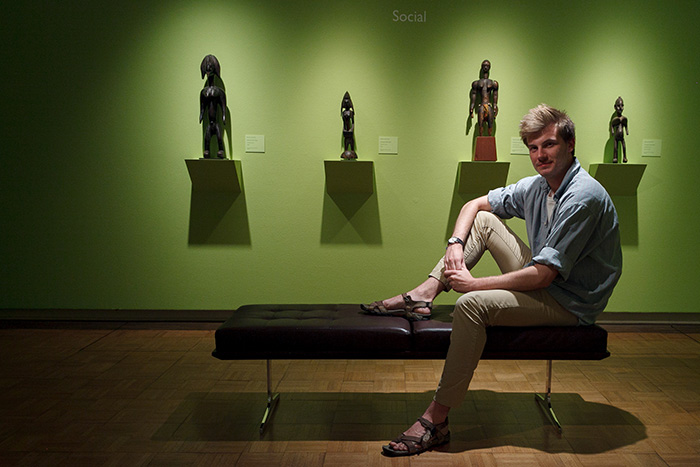The Art Detective

Photo by Carl Socolow '77.
Student-curated exhibition highlights expert findings on African culture and art
by MaryAlice Bitts-Jackson
Taylor Hunkins ’17 had been researching objects in The Trout Gallery’s collection for months, and it was tough from the start. The classical studies and art history major had a theory about two mysterious items, but he couldn’t find evidence to support or refute it. And with the academic year at an end, time was running out.
What was the student-curator to do, as he prepared the labels for an exhibition on dance, performance, masks and ritual objects in African art? Should he have floated his theory? Removed the objects from the exhibition? Kept searching, knowing his deadline was nigh?
That decision represents an unusual opportunity for an undergrad, and it calls on high-level skills that Hunkins has been steadily building during the past three years. The resulting exhibition, Mafilè Fèn: Bamana Dance and Art, is on display now in The Trout Gallery’s upper level and will be celebrated during a joint opening reception on Friday, Sept. 2, along with The Trout Gallery’s downstairs exhibition, Colorama: The World’s Largest Photographs.
Zeroing in
Hunkins began art lessons in childhood; he also developed an early love of history and history museums. He zeroed in on art history during his first year at Dickinson and secured summer internships at The Trout Gallery, the John A. Michener Museum and the Philadelphia Museum of Art.
Through his summer internships, Hunkins learned about museum administration and marketing and development, and at the Trout, he co-developed and presented educational programs for gallery visitors, a task that tapped his interests in writing, history and cultures. Last year, while enrolled in an Africana studies course, he discovered a way to intertwine what he was learning in class and at the gallery in still deeper ways.
Hunkins had become interested in African art after taking an introductory Africana studies course with Associate Professor of Africana Studies Lynn Johnson. After submitting a proposal for an African art exhibition to The Trout Gallery Director Phil Earenfight, he took a class with Assistant Professor of Africana Studies Patricia van Leeuwaarde Moonsammy, which examined the sociocultural significance of performance in Africana communities and was rooted in performance theory, the idea that codes of performance underlie an array of interpersonal interactions, not only in theatre, music and dance, but also in everyday communication, gestures and expressions, religious and secular rituals, acts of state, resistance movements and more.
”It was my first exposure to performance theory, and I really challenged myself to see how it could be incorporated into art historical theory,” says Hunkins, who chose to focus his exhibition on performance culture of the Bamana of sub-Saharan West Africa. An exhibition began to take shape.
Piecing it together
Hunkins admits that this less-studied subject was a tough nut to crack. Reference materials weren’t abundant, and the objects in the collection spanned several decades. Because most of the related scholarship is based on personal observation, experts sometimes interpreted the same performance in different ways and used different definitions of cultural terms.
“It’s been a very dynamic process,” Hunkins says. “I’ve looked at this process as a puzzle—I am slowly gathering more and more pieces.”
Most perplexing: a marionette and a two-headed sculpture that was not referenced in available literature. Hunkins believed they may have been used as puppets in a skit about polygamous marriage, but he couldn’t be sure. With his deadline looming, he crafted a carefully worded label—making it clear that his theory was just that. The Trout’s Curator of Education Heather Flaherty meanwhile connected with the Smithsonian’s curator of Africa ethnology, Mary Jo Arnoldi, on his behalf.
Arnoldi determined that the objects represented a female bush genie, and the colonialists who forced the Bamana into labor and other jobs for their own use, and Hunkins rewrote the label accordingly. The international expert also contributed her own video of Bamana dance ceremonies to the exhibition.
It all leads to exceptional learning opportunities for those who visit the gallery, says Flaherty, who notes that local K-12 teachers and Dickinson professors in anthropology, Africana studies, dance, theatre and art history are planning to incorporate gallery visits into their classes.
And there are profound benefits for the aspiring curator. Hunkins is excited to attend the opening reception on Sept. 2.
“It’s really rewarding to create something that exhibits my interests and hard work,” he says, “but I think it’s even more rewarding when it is something that engages with other people. While I have presented an initial dialogue, there are many more dialogues to be had.”
Learn more
- “Just Live” (Taylor Hunkins ’17)
- “Art Works.”
- The Trout Gallery
- The Arts at Dickinson
- Latest News
Published September 1, 2016